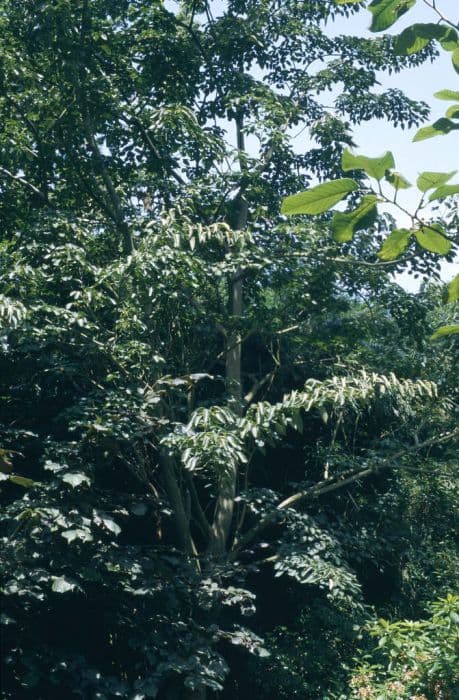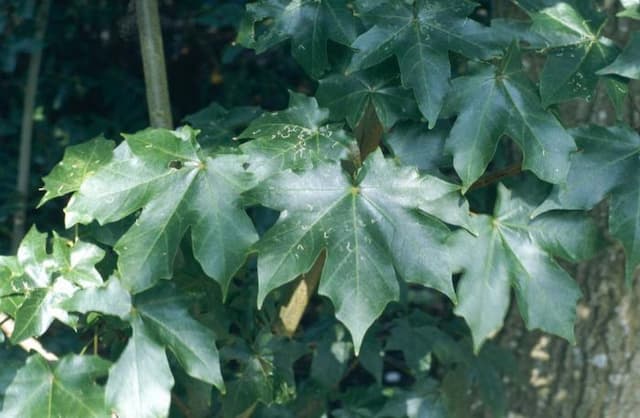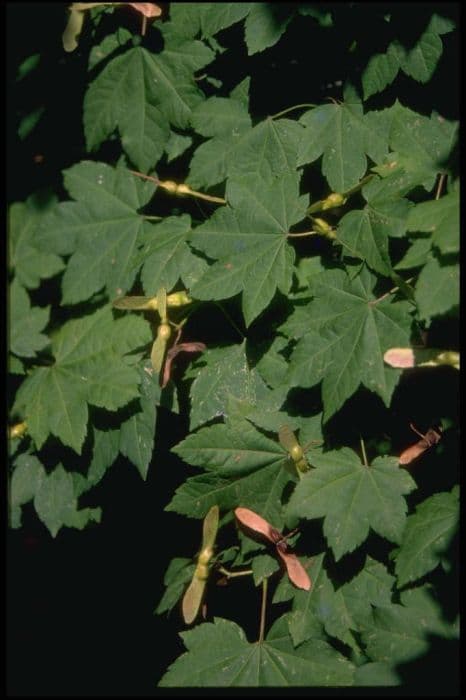Japanese Maple Acer palmatum 'Nigrum' (A)

ABOUT
Acer palmatum 'Nigrum', commonly known as Japanese maple, is a visually striking ornamental plant known for its unique and appealing features. This variant of Japanese maple is particularly noted for its distinctive foliage. The leaves are palmate, resembling the spread fingers of a hand, and are deeply lobed with sharp points, giving them a star-like shape. These leaves go through a fascinating transition of colors throughout the seasons. During spring, the foliage emerges in a deep purplish-red hue, effusing a vibrant and lush appearance. As the seasons progress into summer, the leaves mature to a rich and dark purple, offering a sense of depth and texture to the plant's canopy. The deeply saturated leaf colors become even more pronounced when set against the contrasting lighter greens of other garden plants. With the arrival of autumn, the show isn't over. The leaves of 'Nigrum' Japanese maple transform yet again, this time revealing a brilliant tapestry of colors that can include shades of red, orange, and yellow, creating a spectacular autumn display. This blend of warm seasonal colors produces a striking visual effect in any landscape, ornamental garden, or as a stand-alone specimen. The bark of the Japanese maple 'Nigrum' has a smooth texture and a color that complements the foliage. It is typically a greyish color but can sometimes have hints of red or purple which can be more noticeable during the winter months when the tree is devoid of leaves. This adds year-round interest to the tree, making it an attractive feature in the garden throughout all seasons. Overall, the Japanese maple 'Nigrum' is celebrated for its stunning leaf colors and beautiful seasonal transitions that provide year-round visual interest, even when the detailed dimensions of the plant are not considered.
About this plant
 Names
NamesFamily
Sapindaceae
Synonyms
Black Japanese Maple, Purple Japanese Maple
Common names
Acer palmatum 'Nigrum'.
 Toxicity
ToxicityTo humans
The plant in question is commonly known as Japanese Maple. Japanese Maple is not considered to be toxic to humans, so ingesting parts of this plant typically does not result in poisoning or severe consequences. There are no well-documented reports of toxicity from consuming this plant, and it is generally regarded as safe.
To pets
Japanese Maple is also considered non-toxic to pets, including cats and dogs. There is no significant risk of poisoning if a pet ingests parts of a Japanese Maple. The ingestion of any type of plant material can cause mild stomach upset in some pets, but there should be no serious toxic effects from this plant specifically.
 Characteristics
CharacteristicsLife cycle
Perennials
Foliage type
Deciduous
Color of leaves
Varies
Height
15-25 feet (4.6-7.6 meters)
Spread
10-20 feet (3-6 meters)
Plant type
Tree
Hardiness zones
5-9
Native area
Japan
Benefits
 General Benefits
General Benefits- Aesthetic Appeal: A provides striking foliage color with leaves that transition from green to shades of deep red and purple, adding visual interest to any landscape.
- Seasonal Interest: It offers year-round interest with its evolving leaf colors and attractive bark, particularly noticeable in the winter.
- Shade Tolerance: This plant can thrive in partial shade, making it versatile for garden design in areas with varying light levels.
- Compact Size: It has a relatively small stature, which makes it suitable for use in smaller gardens or limited spaces.
- Easy Pruning: Can be pruned easily to maintain a desired shape or size, which is ideal for bonsai or structured garden designs.
- Drought Resistance: Once established, it has a good level of drought tolerance, reducing the need for frequent watering.
- Cold Hardiness: It is tolerant of cold temperatures, making it suitable for a variety of climates.
- Low Maintenance: Requires minimal care once established, making it a convenient choice for gardeners of all skill levels.
- Wildlife Support: Can be a source of food and habitat for local wildlife like birds and beneficial insects.
 Medical Properties
Medical PropertiesThis plant is not used for medical purposes.
 Air-purifying Qualities
Air-purifying QualitiesThis plant is not specifically known for air purifying qualities.
 Other Uses
Other Uses- Acer palmatum 'Nigrum', commonly known as black Japanese maple, can serve as a natural dye source. - The leaves may be used to produce a natural dye for fabrics, giving them a gentle, earthy tone.
- Seasonal decorations - Its striking dark foliage and interesting form make it a unique choice for fall and Halloween themed arrangements or as a backdrop for festive decorations.
- Creative arts and crafts material - The leaves and seeds (samaras) of black Japanese maple can be incorporated into arts and crafts projects for textures and patterns.
- Photography backdrop - The distinctive foliage and elegant form of the black Japanese maple make it a favorite subject or backdrop for garden and nature photographers.
- Bonsai cultivation - Enthusiasts of bonsai find this variety well-suited due to its leaf size and tree structure, promoting it in miniature art form.
- Educational use - It is often used in botanical studies to demonstrate leaf changes, chlorophyll breakdown in fall, and other biological processes.
- Landscape contrasts - Its dark foliage can be used to create dramatic contrast in gardens, especially against lighter-colored plants.
- Erosion control - By planting black Japanese maples on slopes, they can help in stabilizing soil and preventing erosion due to their root structures.
- Cultural significance - The tree can be used to educate or represent Japanese culture and gardening practices in cultural exhibits or gardens.
- Woodworking material - Although not commonly used, the wood from larger specimens can be crafted into small woodworking projects like jewelry boxes or decorative items.
Interesting Facts
 Feng Shui
Feng ShuiThe Japanese Maple is not used in Feng Shui practice.
 Zodiac Sign Compitability
Zodiac Sign CompitabilityThe Japanese Maple is not used in astrology practice.
 Plant Symbolism
Plant Symbolism- Beauty and Elegance: The Japanese Maple is renowned for its delicate foliage and striking beauty, often symbolizing grace and aesthetic appeal.
- Peace and Tranquility: With its intricate leaves and calm presence, the Japanese Maple often represents peace and creates a tranquil and serene atmosphere.
- Balance and Practicality: The balanced growth habit and adaptability of the Japanese Maple can symbolize the importance of harmony and practical approaches in life.
- Endurance and Patience: As a plant that experiences and endures the changing seasons, the Japanese Maple is seen as a symbol of endurance and the patience to withstand varying conditions.
- Change and Transition: The changing colors of the Japanese Maple's leaves throughout the seasons can represent the transient nature of life, reflecting change and transition.
 Water
WaterThe Japanese Maple requires consistent moisture, but it's important to avoid overwatering. Water the plant deeply once a week, ensuring that the soil is moist but the excess water drains away to prevent root rot. During the growing season in spring and summer, you may need to water more frequently, especially if conditions are particularly dry or windy. A general rule of thumb is to provide approximately 10 to 15 gallons of water per week for a mature tree, adjusted based on rain and temperature. Monitor the moisture level of the soil regularly; it should be damp but not soggy.
 Light
LightJapanese Maples thrive in conditions where they can receive partial shade or filtered sunlight. The best spot for a Japanese Maple like 'Nigrum' is an area that offers protection from harsh afternoon sun, which can scorch the delicate leaves, while still providing enough light to encourage healthy growth. Dappled sunlight under taller trees or a northern or eastern exposure that avoids the intense late-day sun are ideal spots.
 Temperature
TemperatureJapanese Maples prefer temperate climates and can generally withstand winter cold down to about -10 to -20 degrees Fahrenheit. However, the ideal growing temperatures for 'Nigrum' are between 60 and 70 degrees Fahrenheit during the growing season. They thrive in areas where summer temperatures rarely exceed 90 degrees Fahrenheit. When temperatures drop in the fall, this signals the tree to start preparing for dormancy.
 Pruning
PruningJapanese Maples like 'Nigrum' benefit from pruning to remove dead or crossed branches, encourage shape, and maintain overall health. Prune the tree during the winter dormancy period when it has the least impact on tree health. Generally, pruning once a year is sufficient. Focus on thinning out crowded areas to improve air circulation and light penetration, which will enhance the tree's aesthetic and vigor.
 Cleaning
CleaningAs needed
 Soil
SoilJapanese Maple thrives in a well-draining, sandy loam with a slightly acidic to neutral pH of 5.5 to 7.5. A mix of one-third topsoil, one-third peat moss, and one-third perlite or pumice can provide an ideal balance for moisture retention and aeration.
 Repotting
RepottingJapanese Maples should be repotted every two to three years to refresh the soil and encourage healthy growth. Younger trees may require more frequent repotting due to faster growth rates.
 Humidity & Misting
Humidity & MistingJapanese Maple prefers moderate ambient humidity levels but is adaptable to various environments as long as the soil moisture is well-regulated.
 Suitable locations
Suitable locationsIndoor
Position in bright, indirect light; avoid dry air and extremes.
Outdoor
Provide partial shade, shelter from harsh winds, and mulch roots.
Hardiness zone
5-8 USDA
 Life cycle
Life cycleThe life of the Japanese Maple (Acer palmatum 'Nigrum') begins with seed germination, which occurs after stratification, where the seeds experience a period of cold before sprouting when warmth returns in the spring. Following germination, the seedling stage is marked by initial growth of the root system and the emergence of the first set of true leaves above ground. As the sapling continues to grow, it undergoes the vegetative stage, where it invests energy in expanding its foliage and root system, and the trunk begins to thicken. The maturity stage is reached when the Japanese Maple starts to reproduce, developing flowers that are typically inconspicuous, leading to the production of seeds once pollinated. Throughout its adult life, the tree experiences repeated cycles of seasonal growth, flowering, and seed production, with fall showcasing its notable red and purple foliage coloration. Finally, toward the end of its life span, which can be several decades long, the tree's growth slows, and it eventually succumbs to environmental pressures or old age, completing its life cycle.
 Propogation
PropogationPropogation time
Spring-Early Summer
Propogation: The Japanese Maple 'Nigrum' can most commonly be propagated through the method of softwood cuttings taken during the early summer months when the wood is new and yet to harden fully. To do this, a gardener would typically cut a 4 to 6 inch (10-15 cm) stem from a healthy parent plant, making sure there are at least two sets of leaves on the cutting. Leaves on the lower half of the stem should be removed and the cut end dipped into rooting hormone to enhance root development. The cutting should then be placed in a pot filled with a mix of perlite and peat moss to promote drainage and retain sufficient moisture. The pot needs to be kept under indirect sunlight and maintained at a consistent moisture level, but not waterlogged, to encourage rooting. Covering the pot with a plastic bag can help maintain humidity levels and aid in the rooting process. With proper care, the cuttings generally root within a few weeks to a couple of months.








